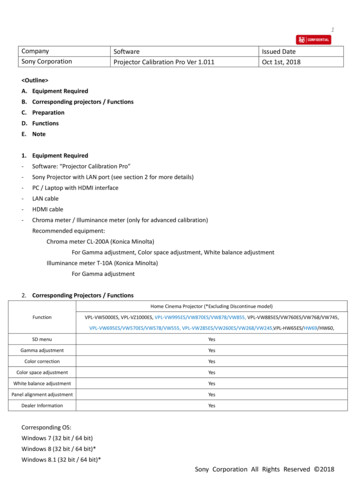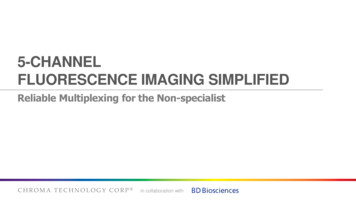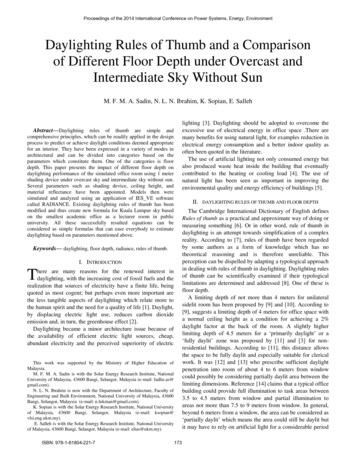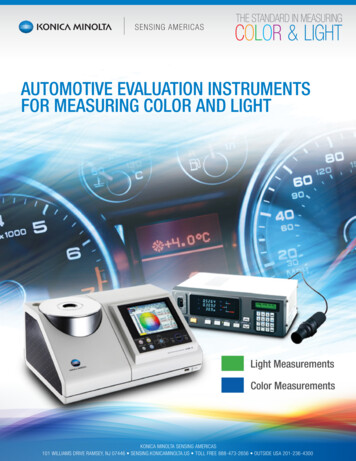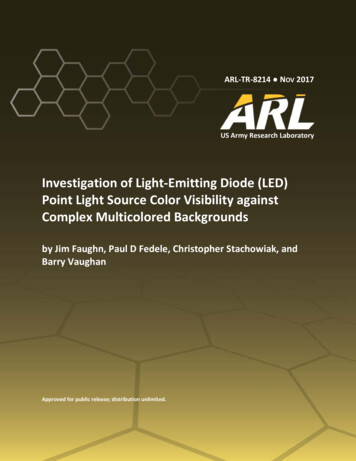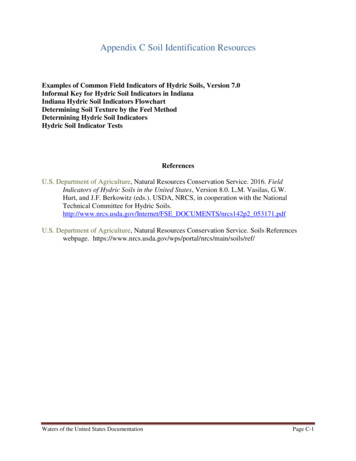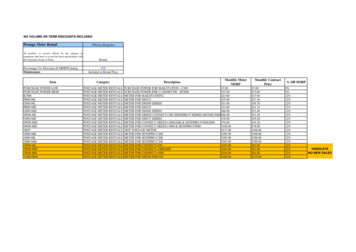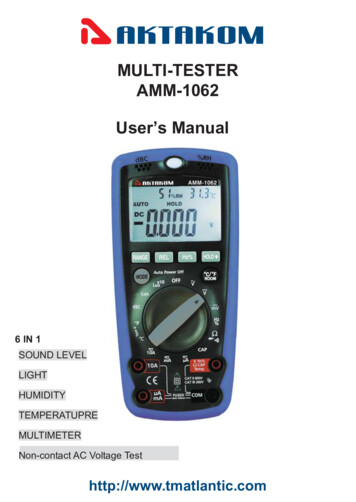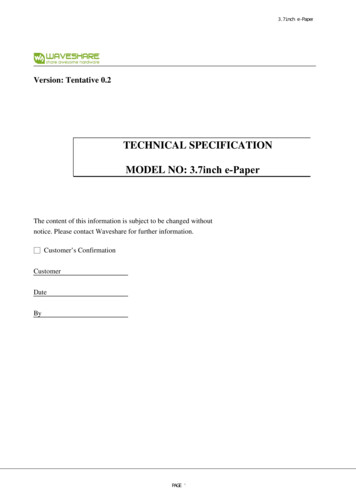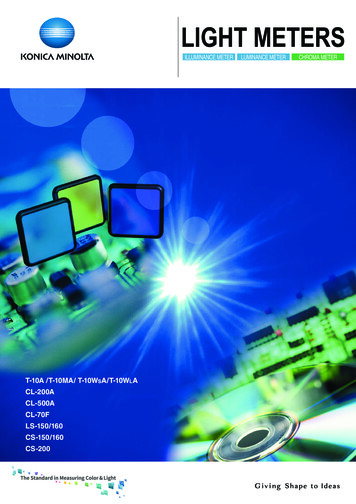
Transcription
ILLUMINANCE METERT-10A /T-10MA/ 0/160CS-200LUMINANCE METERCHROMA METER
illuminance Measurement TrioCross-section A0Illuminance Meterilluminance (lx)3001005030Height (m)1T-10A series21034-35-2-1012Horizontal distance (m)Compatible with new, next-generation light sources including PWM-controlled sources.For simple but accurate illuminance measurements. Makes creating illuminancemeasurement systems such as multi-point measurement systems easy! Standard receptor Mini receptor T-10AT-10MA/T-10WSA/T-10WL AReceptordiffuserwindow:Ø 25 mmReceptordiffuserwindow:Ø 14 mmT-10AConforms to JIS AA Classand DIN class BT-10MA (Cord length: 1 m)Conforms to JIS AA Classand DIN class BEnables illuminancemeasurements of small areas.Can be used for generalmeasurements of illuminance.2Illuminance Meter T-10A seriesCan be used for illuminancemeasurements in narrow spaceswhere the standard receptor won't fit.It can also be easily installed onvarious kinds of equipment or jigsfor measuring light levels such asillumination.T-10WSAT-10WLA(Cord length: 5 m)(Cord length: 10 m)Conforms to JIS requirementsfor special illuminance metersWaterproofCustom orderThe mini receptor and cord are bothwaterproof, so they can be used formeasurements in water.They can be used for illuminancecontrol for fishery-related applications(such as fish farming, etc.) or formeasuring outdoor illuminance onrainy days.3
Main FeaturesReliable, worry-free illuminance meters thatconform to JIS AA Class and DIN Class BCompatible with PWM-controlled lighting. Enablesmeasurements of next-generation light sources.Illuminance Meters T-10A and T-10MA conform to Class AA of JISC 1609-1: 2006 "Illuminance meters Part 1: General measuringinstruments" and DIN 5032 Part 7 Class-B " Photometry;classification of illuminance meters and luminance meters"requirements to provide high-accuracy, high-reliability, worry-freemeasurements.Illuminance meters conforming to these standards are required formeasurements of general illumination light sources, white LED lampsfor illumination, etc. in a variety of industrial fields.Conventional illuminance meters often cannot accuratelymeasure PWM-controlled light sources, but the T-10A seriesof illuminance meters can be used to accurately measureeven such light sources.Removable receptorThe receptor and main body can be detached from each other andthen connected using a LAN cable, making it easy to install as partof an inspection system.Easy, inexpensive multi-point measurement(2 to 30 points).Illuminance distributionof a projector etc. canbe easily measured witha single instrument andseveral receptors.Multi-point illuminance measuring systemzz 5-point example: Architectural lighting, etc.zz 9-point example: Projectors, etc.zz 25-point example: Street lighting, etc. [T-10A 9-point measuring system composition]Illuminant Meter T-10A1 unitT-10A Receptor Head8 unitsAdapter units for Main Body T-A201 unitAdapter units for Receptor Head T-A21 9 unitsAC Adapter1 unitData Management Software T-S10w1 setMain applicationszGovernmentztesting organizationszResearch/inspectionzat illuminationequipment makerszMaintenancezat factories, offices, hospitals,etc.zIlluminancezcontrol of security lighting,street lighting, etc.zAsz sensor for equipment measuring lightdistribution characteristics, etc.Illuminance Meter T-10A series3
D a t a M a n a g e m e n t S o f t w a r e T- S 1 0 w ( O p t i o n a l a c c e s s o r y )Convenient, easy-to-use Excel add-in softwareReads measurement data from T-10A series IlluminanceMeters directly into Excel . Further processing of data canthen be performed easily using the various functions of Excel .specifications of Data Management MainSoftware T-S10wAdd-in for Excel (Excel is required to use this add-in.)OperatingOne of the following environments with Excel :environment Windows 7 Professional 32-bit Excel 2007 32-bit or Excel 2010 32-bitWindows 7 Professional 64-bit Excel 2007 32-bit or Excel 2010 32-bitWindows 8.1 Pro 32-bit Excel 2010 32-bit or Excel 2013 32-bitWindows 8.1 Pro 64-bit Excel 2010 32-bit or Excel 2013 32-bitWindows 10 Pro 32-bit Excel 2013 32-bit or Excel 2016 32-bitWindows 10 Pro 64-bit Excel 2013 32-bit or Excel 2016 32-bitType* OS languages English, Japanese, Simplified Chinese, TraditionalChinese* For details on system requirements for above versions of Windows and/or Excel , refer to their respective specifications.* Not compatible with 64-bit versions of Excel .CompatibleinstrumentsT-10A, T-10MA, T-10WS A, T-10WL A, T-10, T-10M,T-10WS, T-10WLRelative Spectral ResponsivityThe spectralluminous efficiency (λ)Konica Minolta IlluminanceMeters T-10A/T-10MA100Relative spectral sensitivity (%)Cosine Correction 201000100%Ideal curveKonica Minolta IlluminanceMeters h (nm)Ideally, the relative spectral responsivity of the illuminancemeter should match V (λ) of the human eye for photopic vision.As shown in the graph above, the relative spectral responsivityof Konica Minolta Illuminance Meters T-10A/10MA is within6% (f1 ) of the CIE spectral luminous efficiency V (λ).CIE ; Commission Internationale de I Eclairagef1 (CIE symbol) ; The degree to which the relative spectralresponsivity matches V (λ) is characterized by means of the error f1 .Since the brightness at the measurement plane is proportionalto the cosine of the angle at which the light is incident, theresponse of the receptor must also be proportional to thecosine of the incidence angle.For Konica Minolta Illuminance Meters T-10A/10MA, thecosine response f2 is within 3%.The graph above shows the cosine correction characteristicsof Konica Minolta Illuminance Meters T-10A/10MA.About PWM-controlled lightingPWM is the abbreviation of Pulse Width Modulation, and refers tothe method of controlling signal intensity by controlling the ratiobetween the ON period and OFF period of a pulse signal.A pulse signal is a signal which repeatedly alternates between ONand OFF, and the percentage of ON period during a single cycle isreferred to as the "duty cycle".PWM-controlled lighting is a method for controlling the brightnessof a lamp by controlling the duty cycle (lit time) of light from apulse-emission source. As the lit time becomes longer, the lightbecomes brighter, and conversely, as the lit time becomes shorterthe light becomes darker.4Illuminance Meter T-10A seriesPeriod when LED is lit
System DiagramData management using computerPC(commercially available)AA-size batteries2 pcs.Data Management softwareT-S10wT-A15RS-232C printer(commercially available)T-A10Cap (with Strap)T-A13(for T-10A)T-A14(for T-10MA)Adapter Unit forMain BodyCustom orderT-A20T-A21With LAN category 5 cable; 1mExample of cableextensionPrinter CableT-A12LAN (10 BASE-T)category 5 straight cable(commerciallyavailable)Example ofmulti-point SystemExternal powerHard CaseMini CapT-10MA Receptor HeadT-10WSA Receptor HeadT-10WLA Receptor HeadT-10AReceptorHeadData recording using printerCaseAdapter Unit forReceptor Head(IncludingT-A15)USB CableStrapFor multi-point and cable extension measurementAdditional receptors (sold separately; Productincludes 1 receptor according to model purchased)CL-A10AC Adapter Standard accessories Main Specifications of T-10AMini plugT-10A Optional accessories Multi-point measurement requires use ofoptional AC adapter.T-10MAT-10WSAT-10WLACustom modelsIlluminance Meter T-10AIlluminance Meter T-10MAIlluminance Meter T-10WSAIlluminance Meter T-10WL A(Standard receptor head)(Mini receptor head)(Waterproof mini receptor head)(Waterproof mini receptor head)TypeMulti-function digital illuminance meter with detachable receptor head (Multi-point measurements of 2 to 30 points is possible)Conforms to requirements for Class AA of JIS C 1609-1: 2006 "Illuminance meters Conforms to requirements for special Illuminance meters of JIS C 1609-1:Illuminance meter class Part 1: General measuring instruments" Conforms to DIN 5032 Part 7 Class B2006 *1ModelReceptorRelative spectral responsivityCosine correctioncharacteristics (f2)Measuring rangeSilicon photocellWithin 6% (f1 ) of the CIE spectral luminous efficiency V (λ)Within 3%Within 10%Auto range (5 manual ranges at the time of analog output)Illuminance (lx). illuminance difference (lx). illuminance ratio (%). integrated illuminance (lx·h).integration time (h). average illuminance (lx).Illuminance 0.01 to 299,900 lx; 0.001 to 29,990 fcd1.00 to 299,900 lx; 0.1 to 29.990 fcd *2MeasuringIntegrated 0.01 to 999,900 x 103 lx·h 0.001 to 99,990 x 103 fcd·h / 0.001 to 9999 hrangeilluminanceUser calibration functionCCF (Color Correction Factor) setting function: Measurement value x 0.500 to 2.000Linearity 2% 1 digit of displayed valueTemperature/Within 3%humidity driftMeasurement speed2 times/sec. (continuous measurement with 1 receptor head)Computer interfaceUSBPrinter outputRS-232CAnalog output1 mV/digit, 3 V at maximum reading; Output impedance: 10 KΩ; 90% response time: 28 msDisplay3 or 4 Significant-digit LCD with backlight illumination (Automatic illumination)Center of2 AA-size batteries / AC adapter AC-A308 (optional; for 1 to 10receptorreceptors)orReferencewindowPowerAC adapter AC-A311 (optional; for 1 to 30 receptors)35planeØ257.5Battery performance72 hours or longer (when alkaline batteries are used) in continuous measurementCenter ofOperation temperature-10 to 40 C, relative humidity 85% or less5 to 40 C, relative humidity of 85% or lesstripod/humidity range(at 35 C) with no condensation(at 35 C) with no condensationsocketØ45.2Storage temperature /-20 to 55 C, relative humidity 85% or less0 to 55 C, relativehumidity of 85% or lesshumidity range(at 35 C) with no condensation(at 35 C) with no condensation69 x 174 x 35 mmMain body: 69 x 161.5 x 30 mmSize (W x H x D)174Receptor: Ø16.5 x 13.8 mm–1m5m10 mCord length117.5Measuring functionWeight (without battery) 200 g (7.0 oz.)205 g260 g (Receptor head only: 120 g)340 g (Receptor head only: 200 g)*1 Conforms to requirements for Class AA of JIS C 1609-1: 2006 for all items except cosine response (f2).*2 Although measurements below 1.00 lx are possible, they may not be stable due to the effects of electrical noise. Notes regarding mini receptors and waterproof mini receptors *Do not touch the cable during measurements. Doing so may result in unstable measurement values.*Secure the cable during measurements. Failure to do so may result in unstable measurement values.(Units: mm)Center ofreceptor windowØ253069T-10AReferenceplane7.535Center oftripodsocketØ45.2Ø16.5Ø12.7174Ø3117.5Center ofreceptorwindowØ6.5 DimensionsØ14Referenceplane13.6〜13.9161.5Cord length:T-10MA ( 1 m)T-10WSA ( 5 m)T-10WLA (10 m)30Center 10MA/ T-10WSA/ T-10WLAIlluminance Meter T-10A series5
illuminance Measurement Trioy0.90Chroma 0058030002500 2000 5903500*4000A60015004500D55*B610D65 * *D75 * * 460450380〜4400.10 0.20 0.30 0.40 0.50 0.60 0.70xDe facto industry standard for measuringcolor temperature!Can also measure illuminance(JIS AA class)Main FeaturesCompact and easy to carryExcel add-in software includedThe CL-200A's compact body fits in yourpalm. Battery-powered so it can be takenalong and used anywhere.Data Management Software CL-S10w(Standard accessory)Easy, convenient Excel add-inMeasurement data from the CL-200A can be transferreddirectly into Excel . The transferred data can then bemanaged freely within Excel .Includes LED ranking functionData transfer using main body buttonsColor variations, the top topic in the LED industry, can bequantified and a ranking function is also provided.When using the CL-200Awith Data ManagementSoftware CL-S10w(included), measurementscan be taken and datatransferred to Excel usingthe main body buttons aswell as computer keys.OK!Correlated color temperature is determined using theequations defined by JIS (Japanese Industrial Standards).PASSFAILDetachable receptor headThe receptor head can be detached and then connected tothe main body using a normal LAN cable*, making it easy toinstall the sensor in an inspection system.* Optional Adapter Units required for receptor head and main bodyPASSFAIL6Chroma Meter CL-200AJIS correlated color temperatureMulti-point measurement and usercalibration also possibleMulti-point measurement management using up to 30receptor heads is possible.User calibration function enables compensation ofmeasurement values to match a desired standard.Calibration can be performed by two methods: Singlepoint calibration or RGB calibration.
tureerap!temlor aticityocmseosur ChrMea andtinanmo!sdure lengthsaeMe wavsure y!saeitn mon purevE itatiexcApplication examplesF o r eva l u a t i n g l i g h tsource characteristicsWhen using various types of lightsources in a room or open space,it is sometimes necessary to checkthe color of the lighting.By using the CL-200A, it ispossible to adjust the lighting colorso that the food in a restaurant looks delicious.Evaluation of the lightdistribution of LED illuminationmodules or the illuminancedistribution of lighting fixturescan be evaluated.For color-viewingcabinet maintenanceFor projector lightsource research andcolor inspectionA color-viewing cabinet like thatshown at left is used in industriessuch as the printing industry tovisually evaluate finished workunder controlled conditions. Thiscolor-viewing cabinet providesillumination at a specific illuminance and color temperature byusing fluorescent lamps, halogen lamps, etc. The CL-200A canbe used for the daily maintenance and control of these lamps aswell as to indicate when replacement is needed.Illuminance (lx)Cross-section A030010050301Height (m)For lighting productionand adjustment21034-35-2-10123Horizontal distance (m)The CL-200A can be used tomeasure the white balance anduniformity of microprojectors,etc. with internal LED lightsources. The ability to connect multiple receptors using LANcables enables measurement of not only a single point inthe center, but up to a maximum of 30 points over the entireprojected area.For LED billboarddevelopment andmaintenanceThe CL-200A enables qualitycontrol of the LED modules fordigital signage to be performedeasily. If modules with differentcolor tones are used together, the billboard will look mottled,but by measuring the chromaticity and color temperature ofmodules using the CL-200A and selecting modules based onmeasured values, billboard uniformity can be achieved.Multi-point illuminance measuring systemzz 5-point example: Architectural lighting, etc. zz 9-point example: Projectors, etc.[CL-200A 9 point measuring system composition]Chroma Meter CL-200A1 unitCL-200A Receptor Head8 unitsAdapter Unit for Main Body T-A201 unitAdapter Unit for Receptor Head T-A21 9 unitsAC Adapter1 unitData Management Software CL-S10w 1 setzz 25-point example: Street lighting, etc.Chroma Meter CL-200A7
For accurate measurements of color temperature, use the CL-200A!CL-200AThe CL-200A has sensors that closely match the CIE*-defined color-matching functions which are intended to correspondto the response of the human eye to enable precise color measurement. The measurement results can be displayed invarious color notations such as "Correlated color temperature and uv" according to the application.*CIE: International Commission on illuminationPhotographic color meterIn order to take more beautiful pictures, it is sometimes necessary to attach filters in front of the camera lens to compensate forthe color of the light illuminating the subject. A photographic color meter is a meter used to select the appropriate filters, with thesensitivity of its sensors adjusted to match that of the film or digital camera sensor. In addition, because it uses photographiccolor temperature, which is calculated based mostly on the blue/red balance of the illumination, large errors may occur if it isused to measure light sources with non-continuous spectrums.[Actual measurement data for daylight-color LED bulb]Color-temperature difference fromMeasured color temperaturestandard-instrument measured valueOur company's standard instrument5,0450CL-200A5,011-34Photographic color meter5,600555Color temperature and correlated color temperatureColor temperatureWhen an ideal blackbody* is heated, it begins to emit light, and as the temperature increases the color of the emitted lightchanges from red to yellow to white. Since the color of the emitted light is determined by the temperature of the blackbody, thecolor of the light emitted by the blackbody can be expressed as the absolute temperature of the blackbody (in Kelvin). This colornotation scale is called "color temperature". For example, a 7000 K color would be the color of the light emitted by a blackbodyheated to 7000 K. Figure 1 shows the color of light emitted by a blackbody at various temperatures plotted on an xy chromaticitydiagram. This curve is called the "blackbody locus"; "color temperature" expresses a color on this blackbody locus.Correlated color temperatureSince the color of white light emitted by illumination equipment and displays is generally close to the blackbody locus, thecolor of such light sources is normally expressed using "color temperature".However, the color of such light sources is not directly on the blackbody locus. Because of this, a way to enable similarcolor expression for colors within a larger region close to the blackbody locus was devised. This is called "correlated colortemperature", and the larger region is shown by the isotherms on the xy chromaticity diagram in Figure 2.To accurately express the correlated color temperature of a light-source color, it is necessary to state not only thecorrelated color temperature but the difference from the blackbody locus, normally in terms of uv.0.00Chroma Meter 00.254704604500.0480380〜4400.10 0.20 0.30 0.40 0.50 0.60 0.70xFigure 1: Blackbody locus on xy chromaticity diagram80.300650131000000490300.100.3530002500 2000 5903500*4000A60015004500D55 * * B610D65 **D75 * 4555040005100.70054015object that acts similarly.0.5053000blackbody does not actually exist, coal is a familiar5200.80020incident electromagnetic radiation. Although a perfect 0.02uv 0.01uv0uv 0.01 0u.02 vuvAn ideal radiator. A body which completely absorbs ally0.90500000 00*Blackbody0.200.250.300.350.400.450.50Figure 2: Closeup of blackbody locus on xy chromaticitydiagram showing correlated color temperature region0.55
System DiagramOptional receptor headProcessing by computerPC(commerciallyavailable)AA-size batteries 2 pcs.Data Management SoftwareCL-S10wCL-200A*Receptor HeadUSB CableT-A15 (2m)RS-232C printer(commercially available)Adapter Unit forReceptor HeadT-A21Adapter Unit forMain BodyT-A20Printing out dataStrapFor multi-point measurement / detached head*CL-200ReceptorHead canalso be used.Hood CL-A11Printer CableT-A12 (2m)With LAN category-5 cable 1mEx.: Head and bodyconnected viacableLAN(10BASE-T )category-5 straight cable(commerciallyavailable)Case T-A10External PowerHard CaseCL-A10*Not included as standard accessory in some areas. Main Specifications of Chroma Meter CL-200AModelIlluminance meterclassRelative spectralresponsivityCosine correctioncharacteristics (f2)Chroma Meter CL-200AConforms to requirements for Class AA of JIS C 1609-1: 2006 "Illuminancemeters Part 1: General measuring instruments"Closely matches CIE Standard Observer curves x̄(λ), ȳ(λ), and z̄(λ)Within 6% (fi') of the CIE spectral luminous efficency V(λ)Ev: Within 3%ReceptorMeasuringfunctionSilicon photocellTristimulus values: XYZChromaticity: Ev xy; Evu'v'; Ev, Dominant wavelength, Excitation purityCorrelated color temperature: EvTcp uv; Tcp (JIS method; availableonly with CL-S10w)Color difference: (XYZ), (Ev xy), (Evu'v'), Ev u'v'(Target: 1)Other functionUser calibration function, Data hold function, Multi-point measurement(2 to 30 points)0.1 to 99,990 lx, 0.01 to 9,999 fcd (Chromaticity: 5 lx, 0.5 fcd or above) infour automatically selected ranges (lx or fcd is switchable)Ev (Linearity): 2% 1digit of displayed valuexy: 0.002Measuring rangeAccuracy*Repeatability*Ev: 0.5% 1digit (2σ),xy: 0.0005Temperature driftEv: 3% 1digit of displayed value, xy: 0.003Humidity driftEv: 3% 1digit of displayed value, xy: 0.003Measurement speed 2 times/sec. (continuous measurement with 1 receptor head)Computer interface USBPrinter outputRS-232CDisplay4-significant-digit LCD with back-light illuminationOperation temperature/ -10 to 40 C, relative humidity 85% or less (at 35 C) with no condensationhumidity rangeStorage temperature -20 to 55 C, relative humidity 85% or less (at 35 C) with no condensation/ humidity rangePower2 AA-size batteries / AC adapter AC-308 (optional; for 1 to 10 receptors) orBatteryperformanceSize (W x H x D)WeightAC adapter AC-311 (optional; for 1 to 30 receptors)72 hours or longer (When alkaline batteries are used) in continuousmeasurement69 174 35 mm (2-6/16 6-14/16 1-7/13in.)215 g (7.6 oz.) not including batteries DimensionsMulti-point measurement requires use of optional AC adapter.CL-200ASpecifications of Data Management MainSoftware CL-S10wAdd-in for Excel * Excel is required to use this add-in.TypeOperatingOne of the following environments:environment Windows 7 Professional 32-bit or 64-bit Excel 200732-bit or Excel 2010 32-bitWindows 8.1 Pro 32-bit Excel 2010 32-bit or Excel 2013 32-bitWindows 8.1 Pro 64-bit Excel 2010 32-bit, Excel 2013 32-bit, or Excel 2013 64-bitWindows 10 Pro 32-bit Excel 2013 32-bit or Excel 2016 32-bitWindows 10 Pro 64-bit Excel 2013 32-bit or 64-bit, orExcel 2016 32-bit or 64-bit OS languages: English, Japanese, Simplified Chinese,Traditional Chinese For details on system requirements for above versionsof Windows and /or Excel , refer to their respectivespecifications.Compatible CL-200A, CL-200*, CL-500Ainstruments * Some functions not usable with CL-200.Center of receptorwindowReference planeφ257.535Tripod socketφ45.2 Optional accessories 13174 Standard accessories 56.3AC Adapter18Cap T-A13Ex.: Multi-pointmeasurement* 800 lx, Standard Illuminant A measured(Units: mm)30 headWith adapter unit69attached to receptorWith receptor head attached to main bodyReference �18137.5Tripod socket5035φ45.27.5(56.3)φ2556.3Center of receptorwindow27.5307.535Chroma Meter CL-200A9
illuminance Measurement Trio020406080100RaIlluminance 2R13R14R15For evaluation of high-class nextgeneration lamps such as LEDillumination and EL illuminationNow scotopic illuminance can also bemeasured.Main FeaturesThe CL-500A conforms to DIN 5032 Part 7 Class B and JISC 1609-1:2006 General Class AA, making it the first compact,lightweight, handheld illuminance spectrophotometer toconform to both DIN and JIS standards.All-in-one type.No PC needed.The CL-500A can be used by itself for measuring CRI orcolor temperature of lamps.In addition, the spectral irradiance waveform and peakwavelength can also be checked.Scotopic illuminance can also be measured.Most conventional illuminance meters can only measure photopicilluminance, but the CL-500A can also measure *scotopic (darkadapted) illuminance both with the instrument alone and whenused with the included software. Plus, the S/P ratio of scotopicilluminance and photopic illuminance can also be displayed.1.2CIE spectral luminous efficiencyHandheld illuminance spectrophotometerconforms to both DIN and JIS standards.Photopic vision1.0Scotopic vision0.80.60.40.20.0380 420 460 500 540 580 620 660 700 740 780Wavelength (nm)Measurement of spectral irradiance (w/m2) ateach wavelength.The spectral irradiance can be measured at 1-nm pitchfrom 360 to 780 nm, so the CL-500A can be used not onlyfor measuring the color of light but also for measuringphotosynthetic photon flux density (PPFD).Measures and displays both the general colorrendering index Ra as well as the specialcolor-rendering indexes R1 to R15.The special color-rendering indexes R1 to R15 can be displayed,so the color-rendering index for a specific color such as for R9 (red)can be easily measured and displayed.10Illuminance Spectrophotometer CL-500A* Scotopic vision vs. photopic visionThe sensitivity of the human eye under low-light conditions is different than thatunder bright conditions. The vision of the human eye under low-light conditionsis termed “scotopic vision”, with a sensitivity peak wavelength which is shiftedtoward the shorter wavelengths compared to vision under bright conditions,which is termed “photopic vision”. The respective spectral luminous efficiencycurves for each type of vision are shown at right.Convenient measurement functions1) Continuous measurement mode :For monitoring changes in illuminance levels or spectralpower distribution.2) Display of the average of multiple measurements :Useful for evaluation of projectors, etc.3 Delayed-measurement function :The CL-500A can be set to wait for a specific timeafter the measuring button is pressed before startingmeasurements, so you can get out of the way before themeasurement is taken to make sure that light reflectedfrom you or your clothes do not affect measurements.4) Display of data at specific wavelength :Allows monitoring of spectral irradiance at a specificwavelength.
Data Management Software CL-S10w (Standard accessory)Convenient, easy-to-use Excel add-in softwareSpectral irradiance waveform displayReads measurement data from the CL-500A directly intoExcel . Further processing of data can then be performedeasily using the various functions of Excel .Since peak wavelengths can be seen easily, classificationand grading of light sources can be performed easily at highaccuracy. In addition, numerical data at 1 nm can also beviewed in list -012.00E-011.50E-011.00E-015.00E-020.00E 00360400450500550600Wavelength (nm)650700750780Multi-point measurement possible usingmultiple CL-500A unitsData Management Software CL-S10w can be used to controlup to 10 CL-500A units for multi-point measurements. Usingthe SDK, this can be further expanded. Please contact oursales person for further information.Informative color-rendering index displayEquipped with LED binning functionColor-rendering indexes are shown visually for easyunderstanding. The shifts between a test light source and astandard light source can be seen at a glance, with bargraphs showing the general color-rendering index Ra (theaverage of special color-rendering indexes R1 to R8) andthe special color-rendering indexes for a total of 15 colors (R1to R15).In addition to quantifying the color variations which are amajor problem in the LED industry, the software is alsoequipped with function to enable easy binning.0204060800.5000DominantwavelengthBlack .45001000.4000RaR1R2R15 30000.35000.40000.45000.5000R7R10R9R8MacAdam SDCM level displayCL-S10w includes a template for expressing thechromaticity variation of illumination light sourcessuch as LEDs or organic EL sources in termsof the MacAdam SDCM (Standard Deviation ofColor Matching) step. This allows display of colordifferences that closely match visual 0.40500.10000.00000.0000 0.1000 0.2000 0.3000 0.4000 0.5000 0.6000 0.7000 0.8000SDCM of 7500.4800Dominant WavelengthBlackbody LocusMacAdam EllipsesxyIlluminance Spectrophotometer CL-500A11
W h a t i s c o l o演r-色rene rはing proper ty?性dとColors are generally compared by arranging objects side-by-side and looking atthem under natural light (sunlight).When comparing how lamps such as fluorescent lamps, LEDs (light emittingdiodes), etc. make objects look against how natural light makes them look, howclosely the appearances match is called the “color-rendering property” of the lamp.A lamp that produces a hue similar to that of natural light is said to have a good (high)color-rendering property. The color-rendering index is an objective quantificationof the color-rendering properties of a light source. The color-rendering indexexpresses the comparison between the light source being tested and a standardilluminant*. The maximum value is 100, with the value decreasing as the colorrendering difference increases, indicating how far the appearance under the testlight source is from the natural color under sunlight.Standard illuminant(CIE daylight)Light sourcebeing tested* Standard illuminant with the same color temperature as the light source beingtested. (Light along the blackbody locus corresponds to sunlight.)Color-rendering indexes include the general color-rendering index (Ra)and special color-rendering indexes (R1 to R15)Test - color samplesNo. 1No. 2No. 3No. 4No. 5No. 6No. 7No. 9No. 10No. 11No. 12No. 13No. 14No. 15No. 8The general color-renderingindex uses low-chroma colorswith a Munsell Value of 6 andChroma between 4 and 8.No. 9 to No. 15 are realisticcolors.General color-rendering index (Ra)The average of the color-rendering indexes for test colors No.1 to 8.Special color-rendering indexes (Ri)The individual color-rendering index for test colors No. 1 to 15(The index for each individual color is evaluated.)To learn more about the theory and practice of light and color measurement, please ledge/index.htmlKonica Minolta Measurement FundamentalsMain applications Measurement and evaluation of the
Illuminance Meter T-10A series. 3 Reliable, worry-free illuminance meters that conform to JIS AA Class and DIN Class B Illuminance Meters T-10A and T-10MA conform to Class AA of JIS C 1609-1: 2006 "Illuminance meters Part 1: General measuring instruments" and DIN 5032 Part 7 Class-B " Photometry;
